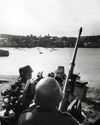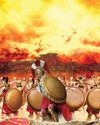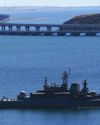Prøve GULL - Gratis
"RAIN OF RUIN" PATH TO HIROSHIMA
History of War
|Issue 149
At the climax of fighting in the Pacific, the USA revealed its ultimate weapon and ushered in a new era of warfare

The bomber will always get through; the only defence is offence,” Stanley Baldwin told the British Parliament in 1932.
Five years later during the Spanish Civil War, Hitler's Condor Legion devastated Guernica with high-explosive and incendiary bombs. Hamburg, Dresden, Cologne, Coventry and other European cities followed in the Second World War. The destructive power of aerial bombardment was also unleashed in the Pacific Theatre: hundreds of thousands died in Tokyo, Osaka, Kobe and more when incendiary bombs ignited wooden homes into unstoppable firestorms. The crescendo of this devastating strategy came when the atomic bombs Fat Man and Little Boy fell on Hiroshima and Nagasaki.
At the outset of the Second World War President Franklin D Roosevelt implored the belligerents to avoid civilian casualties when bombing. Yet even as he made this plea, one of the USA's greatest aviation achievements and the eventual bearer of weapons of mass destruction, the B-29 Superfortress, was already in development.
“The strategy would be that machines do the fighting to save a hell of a lot of casualties. That doctrine dominated American policy even before Pearl Harbor,” says Iain MacGregor, historian and author of The Hiroshima Men. He also notes the economic significance of an aircraft programme that cost more than the Manhattan Project: “Investing that kind of money meant rejuvenating America’s economy. The aircraft industry had taken a pounding during the Great Depression. They deliberately made sure to build the plane in middle America, partly for security – no saboteur could get near it – but also because it revived entire regions of the Midwest.”

Denne historien er fra Issue 149-utgaven av History of War.
Abonner på Magzter GOLD for å få tilgang til tusenvis av kuraterte premiumhistorier og over 9000 magasiner og aviser.
Allerede abonnent? Logg på
FLERE HISTORIER FRA History of War

History of War
BATTLE FOR THE CHANNEL ISLANDS
In 1945, the Allies were ready with a daring amphibious operation to liberate Jersey and Guernsey by force
8 mins
Issue 152

History of War
THE BOYNE
Three crowns were on the line when two kings met in Ireland on a sweltering summer's day
11 mins
Issue 152

History of War
PARIS DAVIS
This pioneering member of the United States Army Special Forces received long-overdue recognition for his heroism rescuing comrades during the Vietnam War
6 mins
Issue 152

History of War
FALL OF THE SPARTANS
The powerful Greek city-state overreached itself and saw its influence decline as it failed to integrate conquered territories
4 mins
Issue 152

History of War
MASTERS OF THE SKIES
From rapidly evolving roles to new technologies, historian and airpower expert John Curatola discusses how fighter planes shaped the Second World War
9 mins
Issue 152

History of War
TEA WITH TRAITORS
A progressive educator celebrated her birthday with a tea party for dissident friends – unaware that a Gestapo informant was among them
9 mins
Issue 152

History of War
CHURCHILL IN THE TRENCHES
How Britain's future war leader earned respect and redemption on the Western Front
13 mins
Issue 152

History of War
"MORE DANGEROUS THAN THE 1950S"
Do we need to relearn the Cold War's fear of mutually assured destruction in our unregulated nuclear landscape?
3 mins
Issue 152

History of War
CRIMEA IN THE CROSSHAIRS
The Black Sea peninsular has been coveted by rival interests for centuries, with the current Russian occupation motivated by several factors
5 mins
Issue 152

History of War
ON THE BRINK
Any conflict between the US and China would almost certainly see the American mainland come under direct attack
3 mins
Issue 152
Listen
Translate
Change font size

